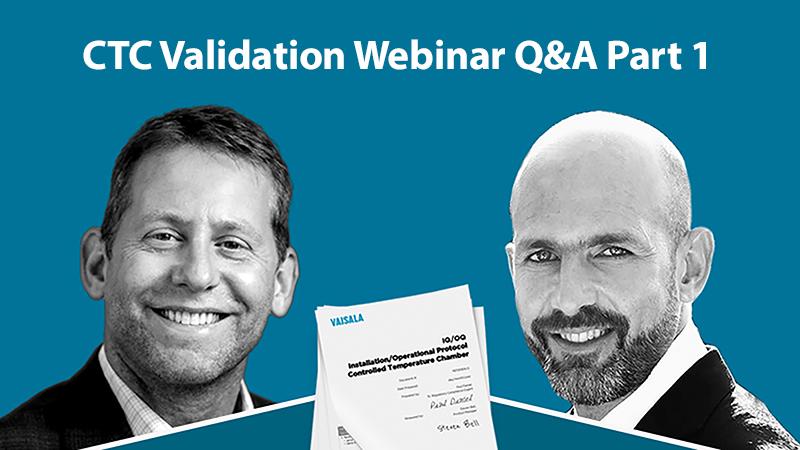Controlled Temperature Chamber Validation Webinar Q&A Part 1
In this first of a 3-part series of video blogs, our presenters will answer the questions on validating temperature-controlled chambers.
For information about services offered by Genesis AEC, visit their website. For information about Vaisala measurement solutions, please contact us. The edited transcript is below the video.
Question: How do you determine number of sensors and how long to map a CTC during a validation?
Paul: Well, that is the number one question that gets asked. For number of sensors and positions, I recommend you refer to the ISPE Good Practice Guide on Controlled Temperature Chambers. This guide will tell you to use nine sensors for all controlled temperature chambers that are less than two cubic meters and use 15 sensors for environments between two and 20 cubic meters. For larger areas, you need to develop a scientific rationale for your sensor placement. Again, you can refer to the ISPE’s guide. Duration of mapping is another issue because there are no recommendations from the guide. Personally, I aim for 72-hour mappings for smaller chambers and rooms and 1 week for larger rooms and warehouses. Longer mappings give you more data and more confidence that the chamber can maintain the required uniformity. In my experience, that is usually enough to satisfy an auditor.
Nathan: For the typical controlled temperature chamber we perform mapping studies on a daily basis, the sensors would be placed in each of the eight corners, with one in the geometric center of the space. So, that’s a minimum of nine sensors. But you don’t want to forget an additional sensor(s), which should be placed adjacent to the display, control, and monitoring probes. This is a good configuration for most refrigerators, freezers, and incubators. This layout is of course dependent on the size of the unit you are mapping, for example, counter height units vs. upright or double door units. For larger units, you could place 5 sensors on the middle shelf, or even lay out an alternate pattern on the middle shelves. As for duration, in my experience providing this service, chambers are mapped at 24 hours, walk-in cold rooms at 72 hours, and warehouses are a minimum of seven consecutive days.
Question: Is there any requirement/limit for open-door recovery tests and power fail tests?
Nathan: There is no regulatory requirement for these tests, however there is guidance that speaks of performance testing. I refer you to USP <1079> Good Storage and Distribution Practices for Drug Products. Let’s look at what USP <1079> says:
“Temperature mapping should account for maximum and minimum loads to capture temperature variability resulting from variations in temperature mass of the payload. Performance of equipment under extreme scenarios including door open, door closed, and simulated equipment failure should be taken into account.”
This answers the question – there is no requirement or limit for the open door or power fail testing.
Question: Would you consider the VL-1000-21N to be semi-buffered during temperature mapping? The thermistor is hidden inside the logger and not fully exposed to the air…
Paul: While I appreciate the distinction you are trying to make; I would not consider this to be buffered. The VL-1000-21N data logger has an internal sensor, but it is not hidden deep inside the data logger body. The sensor is right at the edge of the PCB next to generous vents cut in the side of the data logger housing which allows it to measure air temperature. I grant that the sensor inside the logger body – as opposed to a cabled sensor from the logger body – will affect the response time. But the difference is small, maybe 15 seconds.
Most sensors are protected in some way so they can have a long life, for example, your average RTD appears to be a metal cylinder, but that is just a housing covering the sensing element. So, if we applied the same rationale, we would have to call a normal RTD semi-buffered. When dealing with protected sensors, it is probably better think in terms of reaction times. There is a clear distinction between a protected sensor with a short reaction time and a buffered sensor located in media (example thermal block) that has a large thermal mass relative to the sensor itself.
Question: In mapping a freeze dryer, can we use the same approach that we use for chambers?
Paul: I would not use the same approach with a freeze dryer as with a controlled temperature chamber. One difference is that a chamber is often used for static storage processes, where the chamber is maintaining the load at a stable temperature for an undefined amount of time. Freeze drying is very different; it’s a process by which a product is cooled under vacuum conditions to remove moisture through freezing and sublimation. Freeze drying is a dynamic batch process with defined success criteria at the end. This means there has to be different acceptance criteria for freeze drying process. I consider mapping a lyophilizer to be similar to mapping a sterilizer or autoclave. A controlled temperature chamber is a static process with no end. Some of the techniques might overlap, for example: mapping, pre-calibration, post-calibration, etc.
Nathan: I agree that a freeze dryer will not have the same qualification tests as a CTC because a freeze dryer operation will go through different phases and temperature changes and pulling vacuum. Freeze dryers are validated or qualified to ensure proper functionality according to ISO 13408-3:2006 "Aseptic processing of health care products — Part 3: Lyophilization". A few examples of tests in a freezer dryer validation would be mapping the freeze dryer shelf temperature with no load and with a load, SIP (if applicable), and a vacuum test.
Read the other video blogs in this series:

Add new comment